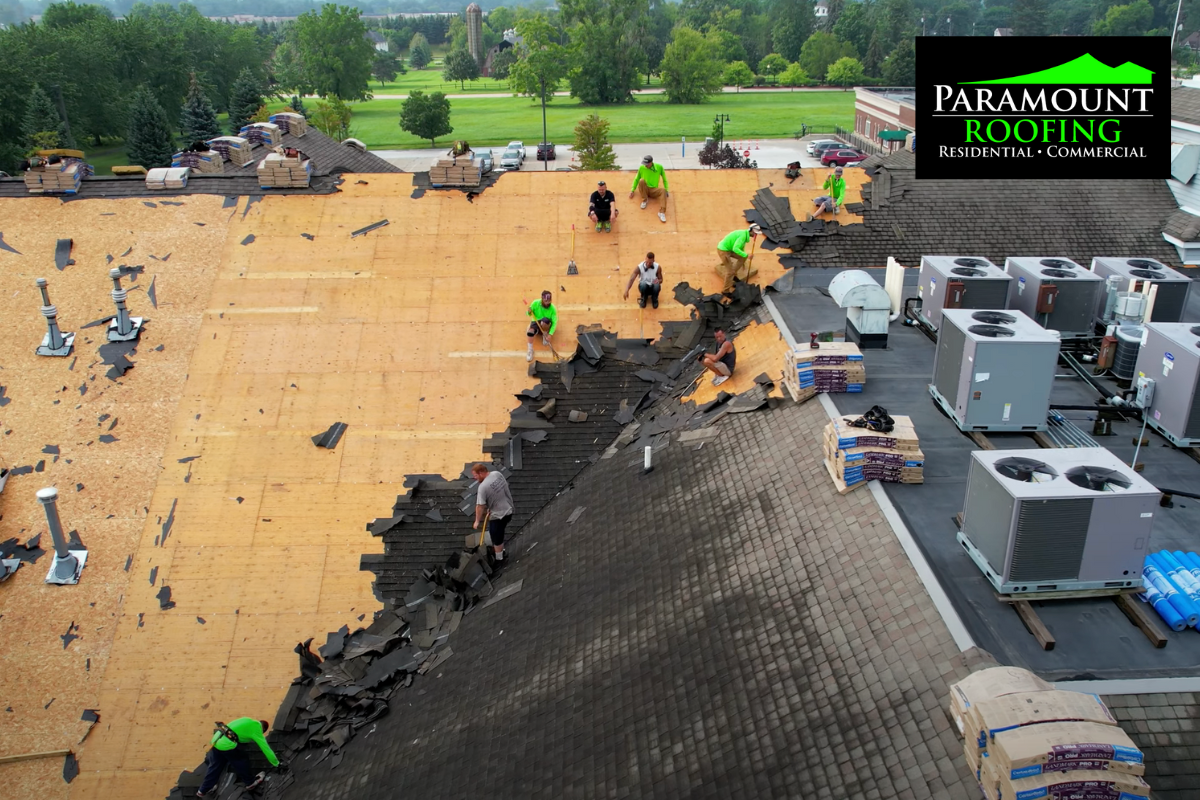Replacing a roof is no small investment, and its importance to your house is hard to overstate. To be sure that you get the best value and protection from your new roof as possible, follow this expert guide from Paramount Roofing.
SIGNS THAT YOU SHOULD REPLACE YOUR ROOF
These are telltale signs that you should replace your roof. Even if they seem like they could be solved with minor repairs, they may have opened the door to damage beneath the surface.
- Cracked Shingles – If you’ve got cracks in some shingles, you may be able to just replace those shingles. However, if they’ve been cracked for a while, chances are some water has leaked through and is damaging the structure of your roof.
- Worn-Down Shingles – If the rough granules on your shingles (usually a lighter color than the base of the shingle) have been worn away, then your roof doesn’t reflect as much heat as it should. You’ll start to notice this on your energy bill.
- Curled Shingles – Not only is this more unsightly than most shingle problems, but it also leaves wider openings for wind and rainwater to seep through your roof.
- Major Roof Damage – The rule of thumb when it comes to roof repairs is that if you have to repair over 35% of your roof, then you’ll get better long-term value out of a roof replacement.
- Leaking Often – If you feel like you’ve been patching up more leaks than you should have to, this problem won’t just go away. This points to a structural issue that will keep causing leaks again and again.
- Neighbors Replacing Roofs – Now, you don’t have to copy everything your neighbors do. But, when they’re putting brand new roofs on their homes, your roof is going to look beaten up and old by comparison. This contrast will affect your home’s curb appeal and therefore its value.
CAN I JUST ADD A SECOND LAYER OF SHINGLES?
You can, but no more than a second layer. This isn’t always the best choice, there are times when you should replace the first layer instead of adding on top of it. You should replace your original shingles when:
- There is loose flashing around chimneys or vents that need replacing
- The first layer of shingles has higher dimensions, leaving the second layer looking uneven
- There are soft, sagging spots in your roof that point to structural weakness
- Your roof’s structure can’t hold the weight of the second layer of shingles
ROOF UNDERLAYMENT
Your roof underlayment is what’s covering your roof structure before shingles are installed. The underlayment serves as the last line of defense against any wind or rain that finds its way under the shingles.
TYPES OF ROOF UNDERLAYMENT
- Synthetic – Growing in popularity, synthetic underlayment is more expensive but has plenty of advantages. They are lighter, resistant to tears, and cooler on hot days. Plus, some kinds are breathable, which allows moisture in the attic to escape before it starts to rot wood or grow mold.
- Asphalt – Asphalt-saturated paper comes in two grades, #15 and #30. #30 paper is twice as heavy, but it ends up taking an average of $250 off your home’s energy bill. There is also rubberized asphalt and modified bitumen. These are more expensive, but they’re generally only needed in extreme circumstances like very hot climates.
- Moisture and Ice Barrier – For roofs that have sections that come together and form a valley, these areas are at especially high risk for water damage since most of the water flows through them. Adding a layer of moisture and ice barrier that covers at least a foot of space on each side of the valley will help protect against leaks in these vulnerable areas.
- Starter Strip – Like valleys, the eaves of your roof are high-risk areas, but in this case for ice dams and wind. It is standard practice for roofers to install a starter strip of shingles at the eaves for this reason.
KEYS TO EFFECTIVE ROOF VENTILATION
Without effective ventilation for your roof, you can expect more issues that need repairs and a shorter lifetime overall. Ventilation helps to clear out damaging heat and moisture from your attic, which degrades the wooden structure of your roof. Heat and moisture will be generated by everyday activities in your home such as showering or boiling water, so you need good ventilation to release it. Here are keys to good roof ventilation:
- Soffit Vents – The soffit is the area under your roof’s eaves. Many soffits are perforated, allowing built-in ventilation. If your soffit is solid, you’ll want to install some soffit vents.
- Ridge Vents – At the peak of your rooftop, there should be openings on either side to allow heat and moisture to escape. In this space, you can install ridge vents that are solid on top where the shingles sit and open on the sides. In order to have ridge vents, you need soffit vents.
- Roof Vents – Having an extra vent or two won’t hurt. You can use passive vents or vents with fans that actively remove more heat and moisture. This is especially helpful in larger homes.
- Gable Vents – If your home has two gabled sides on the roof, then gable vents can be a big help for you. These vents allow cross-breezes to run through the attic and clear heat and moisture passively.
EFFECTIVE ATTIC INSULATION PREVENTS ICE DAMS
Your attic needs to be insulated from the rest of the home, or else you’re setting up conditions for harmful ice dams. This means your attic should be as cold as the outside air during winter. If your attic is warmer, it will melt snow on your roof. This snow will collect as water, and if it’s cold enough outside, freeze into an ice dam that will wear down shingles and even the structure of your roof.
TYPES AND FEATURES OF ASPHALT SHINGLES
Asphalt shingles are the most budget-friendly and most common shingles used. There are three common grades of asphalt shingles:
- Three-Tab – The most basic level, three-tab asphalt shingles are the most affordable grade. They give the classic shingled roof look, but they are not the best for value in the long-run.
- Dimensional or Architectural – This grade is made of two layers. The first layer is a base, then the top layer is fused to the base. The top layer is cut to look like traditional shingles or shake.
- Luxury Dimensional or Architectural – These work the same way as regular dimensional or architectural, but their top layer is cut and raised higher in order to create a more striking look for your roof.
TYPES AND FEATURES OF METAL ROOFING
While not nearly as common as asphalt shingles, metal roofing is the next most common type of roofing.
- Standing Seam – The standing seam allows rainwater to run off of the roof without leaking into the roof. This is the most common kind of metal roofing, but also the most expensive. They’re usually made with steel, but are also made with aluminum.
- Metal Shakes, Shingles – Your metal roofing can also be stamped to resemble shakes, shingles. They’ll be the same shape and appearance, they can be the same color as the real thing, and they also can have granules added which will reflect more light and lower surface temperature
PARAMOUNT ROOFING – EXPERT ROOF REPLACEMENT OF ALL KINDS IN MACOMB COUNTY
Is your roof looking old and tired? Are you tired of having to consistently pay for repairs to patch up recurring damage? Does your roof add unnecessary and preventable costs to your energy bill? If any of these are true, get in touch with Paramount Roofing so that we can give you the roof you deserve. Your roof is your most important asset in protecting your home against the elements, so you should have one that can do its job effectively. No matter what kind of roof you’re looking for, our experts know how to effectively install it on your home. If you’re not sure what sort of roof is best for your budget and your needs, let us know and we’ll share our expertise.
To get a FREE quote on a roof replacement, call now at (586) 571-9007!
 Free Estimate
Free Estimate

